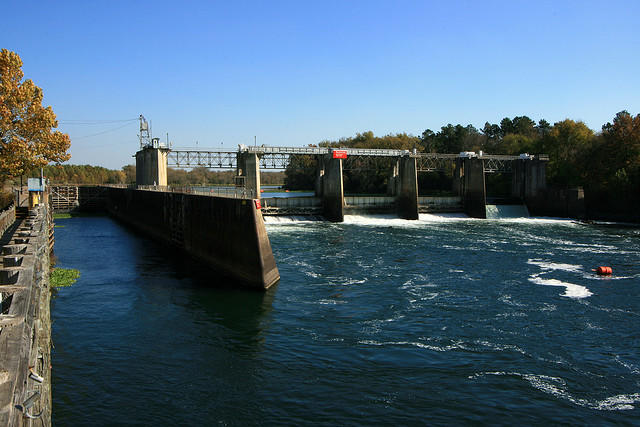Section Branding
Header Content
No Questions Allowed At Army Corps Of Engineers Public Meeting In Augusta
Primary Content
A crowd of several hundred gathered in Augusta Wednesday evening to ask representatives from The Army Corps of Engineers how they came to the decision to demolish The New Savannah Bluff Lock and Dam, in spite of overwhelming objections from local residents on both sides of the Savannah River in Georgia and South Carolina.
Removing the structure was one of several options under consideration as part of the environmental remediation connected to The Savannah Harbor Expansion Project.
The meeting did not go as expected.
Army Corps of Engineers Savannah District Commander Col. Daniel Hibner began his presentation by saying, “Due to ongoing litigation, I can no longer take questions as I intended tonight.”
The audience responded with a number of loud comments, such as, “it figures” and “how convenient.”
With that opening statement, Hibner turned what many hoped would be a constructive dialogue into a scripted monologue. He went on to explain that the Corps had decided to replace the lock and dam with a series of rock weirs that would enable endangered sturgeon species to access their historic spawning grounds for the first time since the lock and dam was constructed in 1937.
While the rock weirs will improve the lot of the fish, it will lower the water level through downtown Augusta by at least 2 feet. The Corps ran a simulation of conditions on the river with the rock weirs replacing the lock and dam back in February.
It left navigation hazards exposed, docks resting on mud flats, and residents outraged.
In the summary of the decision to remove the lock and dam posted on their website, The Corps says that the simulation was flawed due to construction work on a dam upstream.
“Some folks saw it a little bit better than it would have been," Hibner said. "Others saw it a little bit worse. We had a little more variance then we wanted.”
Changes to the plan approved by the Corps are possible, but they warn that it could increase the risk of nuisance flooding. And, since federal spending on the environmental remediation for The Savannah Harbor Expansion Project is capped, any addition expense would have to be borne by state and local governments.
South Carolina has already filed a suit in federal court seeking to prevent the Corps from removing the lock and dam. Georgia is considering a similar course of action.
While the suit(s) make their way through the courts, the Corps says they will proceed based on the assumption that they will prevail.
“We will spend the next year maturing our design," Savannah District’s Chief of Corporate Communications Russell Wicke explained. "Once the design process is complete, we will look to advertise a contract.”

